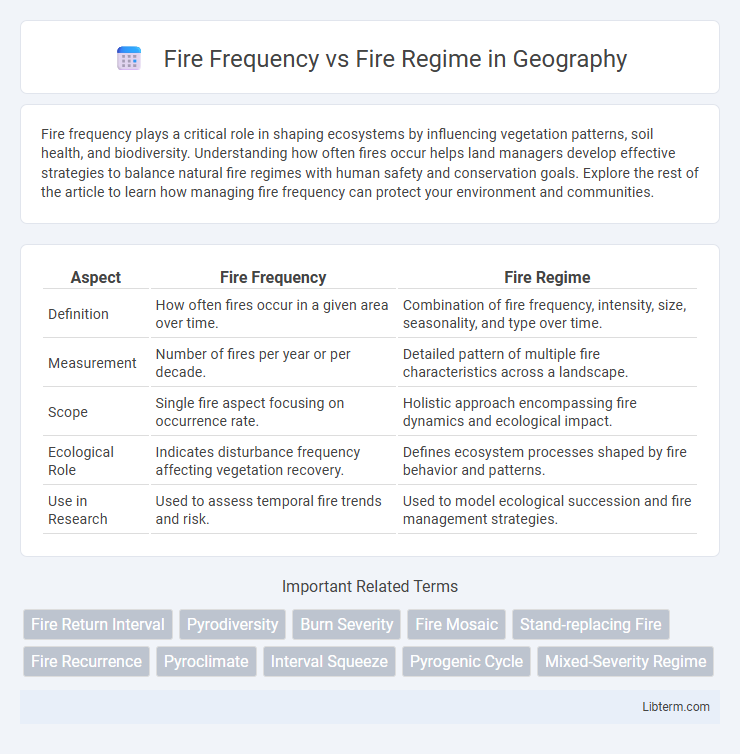Fire frequency plays a critical role in shaping ecosystems by influencing vegetation patterns, soil health, and biodiversity. Understanding how often fires occur helps land managers develop effective strategies to balance natural fire regimes with human safety and conservation goals. Explore the rest of the article to learn how managing fire frequency can protect your environment and communities.
Table of Comparison
| Aspect | Fire Frequency | Fire Regime |
|---|---|---|
| Definition | How often fires occur in a given area over time. | Combination of fire frequency, intensity, size, seasonality, and type over time. |
| Measurement | Number of fires per year or per decade. | Detailed pattern of multiple fire characteristics across a landscape. |
| Scope | Single fire aspect focusing on occurrence rate. | Holistic approach encompassing fire dynamics and ecological impact. |
| Ecological Role | Indicates disturbance frequency affecting vegetation recovery. | Defines ecosystem processes shaped by fire behavior and patterns. |
| Use in Research | Used to assess temporal fire trends and risk. | Used to model ecological succession and fire management strategies. |
Introduction to Fire Frequency and Fire Regime
Fire frequency refers to the number of fires occurring in a specific area over a defined period, providing quantitative data on fire occurrence patterns. Fire regime encompasses the broader characteristics of fire in an ecosystem, including fire frequency, intensity, seasonality, and size, shaping the ecological effects and landscape dynamics. Understanding fire frequency within the context of fire regime is essential for assessing fire's role in ecosystem processes and management strategies.
Defining Fire Frequency
Fire frequency refers to the number of times a fire occurs in a specific area over a set period, typically measured as return intervals in years. It quantifies how often fires ignite within an ecosystem, influencing vegetation patterns and fuel accumulation. Understanding fire frequency is crucial for managing fire regimes, which encompass the combined effects of frequency, intensity, size, and seasonality of fires.
Understanding Fire Regime
Fire regime encompasses the patterns, frequency, intensity, and types of fires occurring in a specific ecosystem over time, providing a comprehensive framework for understanding fire dynamics. Unlike fire frequency, which solely measures how often fires occur, fire regime integrates factors such as seasonality, size, and severity to assess ecological impacts on vegetation, soil, and wildlife. Understanding fire regime is essential for managing landscapes, predicting ecological responses, and implementing effective conservation strategies tailored to natural fire cycles.
Key Differences Between Fire Frequency and Fire Regime
Fire frequency refers to how often fires occur in a specific area over a set period, typically measured in years or decades. Fire regime encompasses not only fire frequency but also fire intensity, seasonality, size, and type, providing a comprehensive characterization of fire patterns in an ecosystem. Understanding the distinction between fire frequency as a simple interval measure and fire regime as a multifaceted ecological framework is crucial for effective fire management and ecological research.
Factors Influencing Fire Frequency
Fire frequency refers to how often fires occur in a specific area, while fire regime encompasses the overall pattern, including intensity, size, and seasonality of fires. Factors influencing fire frequency include climate conditions such as temperature and precipitation, fuel availability and type, as well as human activities like land use and fire management practices. Vegetation composition and topography also play critical roles by affecting fire spread and ignition likelihood.
Components of Fire Regimes
Fire regimes encompass multiple components including fire frequency, intensity, size, type, and seasonality, which collectively describe the patterns and effects of fire in an ecosystem. Fire frequency specifically refers to how often fires occur in a particular area within a set time frame, serving as a key metric but only one aspect of the broader fire regime. Understanding these components allows for better management and prediction of fire impacts on vegetation, wildlife habitats, and nutrient cycling.
Ecological Implications of Fire Frequency
Fire frequency, defined as how often fires occur in an ecosystem, directly influences species composition, nutrient cycling, and habitat structure by controlling vegetation recovery time. Frequent fires tend to favor fire-adapted species and maintain early successional habitats, while infrequent fires allow for the accumulation of biomass and increased risk of high-severity wildfires. Understanding fire frequency is essential to managing fire regimes for biodiversity conservation and ecosystem resilience.
Impact of Fire Regimes on Biodiversity
Fire regimes, characterized by the frequency, intensity, and seasonality of fires, critically shape biodiversity by influencing species composition and ecosystem resilience. Frequent fires can favor fire-adapted species but reduce overall habitat complexity, while infrequent fires may lead to the dominance of fire-sensitive vegetation, altering habitat availability for diverse fauna. Understanding fire frequency within the broader fire regime framework helps in managing landscapes to maintain ecological balance and promote species richness.
Fire Management: Frequency vs. Regime
Fire frequency refers to how often fires occur in a specific area, while fire regime encompasses the overall pattern of fire events, including frequency, intensity, seasonality, and type. Effective fire management requires understanding both fire frequency and fire regime to implement strategies that reduce wildfire risks and promote ecosystem resilience. Adjusting fire frequency through controlled burns can help restore natural fire regimes, maintaining ecological balance and reducing hazardous fuel accumulation.
Future Perspectives in Fire Ecology
Future perspectives in fire ecology emphasize the integration of fire frequency and fire regime to enhance predictive models of ecosystem resilience and carbon dynamics. Advances in remote sensing and machine learning enable more precise mapping of fire frequency patterns, which when combined with fire regime characteristics such as intensity, seasonality, and spatial heterogeneity, improve management strategies for wildfire mitigation. Emerging research prioritizes adaptive fire management that aligns with changing climate conditions, aiming to preserve biodiversity and support ecosystem services under shifting fire regimes.
Fire Frequency Infographic

 libterm.com
libterm.com